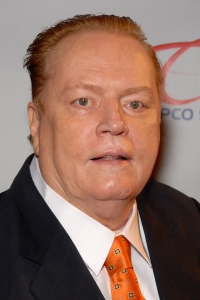
Larry Flynt, who took mainstream pornography to a new low, was an unlikely champion of the First Amendment. Then again, most First Amendment champions are unlikely. As Oliver Wendell Holmes Jr. put it, it’s “freedom for the thought that we hate” that needs protecting, not anodyne statements that offend no one.
Flynt, who died Wednesday at 78, many years after surviving an assassination attempt that left him partially paralyzed, achieved freedom-of-speech immortality because of a parody that he published in his magazine Hustler. It took up a full page and was meant to look like an ad, although the words “Ad Parody — Not to Be Taken Seriously” did appear at the bottom. The fake ad was a takeoff on a series of a real ads for Campari liqueur in which various celebrities talked about their “first time.” The idea was to make it appear they were discussing the first time they’d had sex, only to reveal at the end that they were talking about the first time they drank Campari.
The Hustler parody starred the Rev. Jerry Falwell, founder of the Moral Majority, a leader of the first wave of right-wing television evangelists and a figure of revulsion among liberals. Among other things, Flynt’s Falwell spoke about the “first time” he’d had sex with his mother in an outhouse.
Falwell sued for libel and the intentional infliction of emotional distress, arguing on the latter count that the parody met the legal standard for “outrage.” The case, Hustler Magazine v. Falwell, decided by the U.S. Supreme Court in 1988, established two important principles.
First, on the libel claim, Falwell contended that the parody was false and defamatory. Since he was a public figure, he also had to establish that Hustler published it knowing or strongly suspecting that it was false. A federal appeals court had thrown out the libel count on the grounds that there were no statements in the ad that could be subjected to a true-or-false test. In other words, no reasonable person could possibly believe that Falwell had sex with his mother in an outhouse and had then talked about it for a liqueur ad. The Supreme Court upheld the lower court’s ruling.
Second, the Supreme Court overturned the appeals court’s ruling on the emotional-distress allegation. In so doing, the high court imposed the Times v. Sullivan “actual malice” libel test to claims of emotional distress: in order for a public official or public figure to win such a suit, they would have to show that the offending material contained a false statement of fact — again, with the knowledge that it was false or strongly suspecting it was false. The ruling established a significant new protection for parody and satire.
The unanimous decision, written by Chief Justice William Rehnquist, compared the parody to previous work by Thomas Nast about the corrupt Tweed ring in New York, vicious cartoons about George Washington, and other political and public figures. Rehnquist wrote:
There is no doubt that the caricature of respondent [Falwell] and his mother published in Hustler is at best a distant cousin of the political cartoons described above, and a rather poor relation at that. If it were possible by laying down a principled standard to separate the one from the other, public discourse would probably suffer little or no harm. But we doubt that there is any such standard, and we are quite sure that the pejorative description “outrageous” does not supply one. “Outrageousness” in the area of political and social discourse has an inherent subjectiveness about it which would allow a jury to impose liability on the basis of the jurors’ tastes or views, or perhaps on the basis of their dislike of a particular expression.
Whenever I teach our First Amendment course, I assign my students to write about a major case of their choosing. Inevitably, half the papers are about Hustler v. Falwell, nearly always accompanied by a copy of the ad — just in case I’d forgotten what it looked like, I suppose.
And if you ever get a chance to see the 1996 movie “The People v. Larry Flynt,” you should. It’s a rollicking good portrayal of the whole affair.
Become a member! For $5 a month, you can support Media Nation and receive a weekly newsletter with exclusive content. Just click here.
